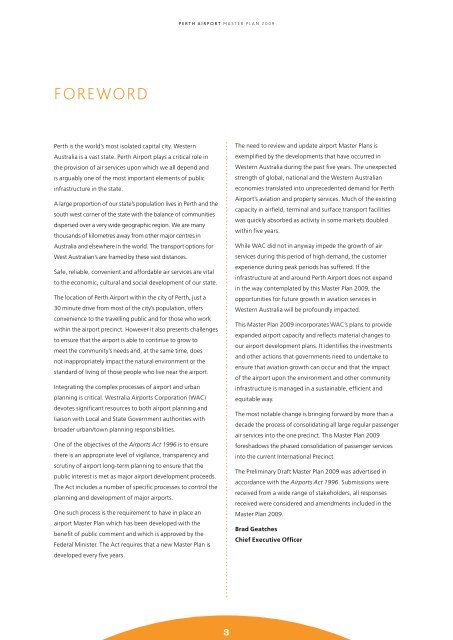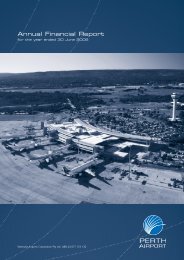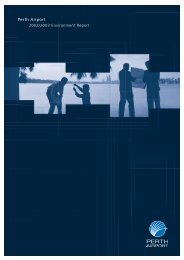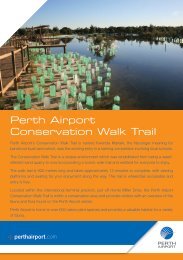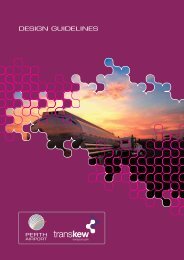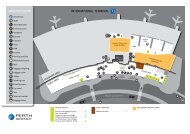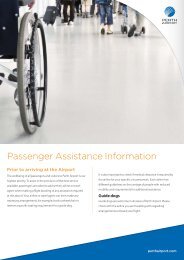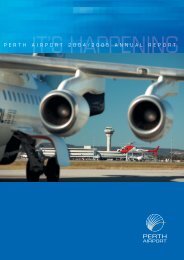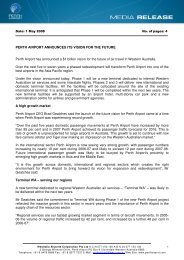PERTH AIRPORT Master Plan 2009
PERTH AIRPORT Master Plan 2009
PERTH AIRPORT Master Plan 2009
You also want an ePaper? Increase the reach of your titles
YUMPU automatically turns print PDFs into web optimized ePapers that Google loves.
P E R T H A I R P O R T M a s t e r P l a n 2 0 0 9<br />
Foreword<br />
Perth is the world’s most isolated capital city. Western<br />
Australia is a vast state. Perth Airport plays a critical role in<br />
the provision of air services upon which we all depend and<br />
is arguably one of the most important elements of public<br />
infrastructure in the state.<br />
A large proportion of our state’s population lives in Perth and the<br />
south west corner of the state with the balance of communities<br />
dispersed over a very wide geographic region. We are many<br />
thousands of kilometres away from other major centres in<br />
Australia and elsewhere in the world. The transport options for<br />
West Australian’s are framed by these vast distances.<br />
Safe, reliable, convenient and affordable air services are vital<br />
to the economic, cultural and social development of our state.<br />
The location of Perth Airport within the city of Perth, just a<br />
30 minute drive from most of the city’s population, offers<br />
convenience to the travelling public and for those who work<br />
within the airport precinct. However it also presents challenges<br />
to ensure that the airport is able to continue to grow to<br />
meet the community’s needs and, at the same time, does<br />
not inappropriately impact the natural environment or the<br />
standard of living of those people who live near the airport.<br />
Integrating the complex processes of airport and urban<br />
planning is critical. Westralia Airports Corporation (WAC)<br />
devotes significant resources to both airport planning and<br />
liaison with Local and State Government authorities with<br />
broader urban/town planning responsibilities.<br />
One of the objectives of the Airports Act 1996 is to ensure<br />
there is an appropriate level of vigilance, transparency and<br />
scrutiny of airport long-term planning to ensure that the<br />
public interest is met as major airport development proceeds.<br />
The Act includes a number of specific processes to control the<br />
planning and development of major airports.<br />
One such process is the requirement to have in place an<br />
airport <strong>Master</strong> <strong>Plan</strong> which has been developed with the<br />
benefit of public comment and which is approved by the<br />
Federal Minister. The Act requires that a new <strong>Master</strong> <strong>Plan</strong> is<br />
developed every five years.<br />
The need to review and update airport <strong>Master</strong> <strong>Plan</strong>s is<br />
exemplified by the developments that have occurred in<br />
Western Australia during the past five years. The unexpected<br />
strength of global, national and the Western Australian<br />
economies translated into unprecedented demand for Perth<br />
Airport’s aviation and property services. Much of the existing<br />
capacity in airfield, terminal and surface transport facilities<br />
was quickly absorbed as activity in some markets doubled<br />
within five years.<br />
While WAC did not in anyway impede the growth of air<br />
services during this period of high demand, the customer<br />
experience during peak periods has suffered. If the<br />
infrastructure at and around Perth Airport does not expand<br />
in the way contemplated by this <strong>Master</strong> <strong>Plan</strong> <strong>2009</strong>, the<br />
opportunities for future growth in aviation services in<br />
Western Australia will be profoundly impacted.<br />
This <strong>Master</strong> <strong>Plan</strong> <strong>2009</strong> incorporates WAC’s plans to provide<br />
expanded airport capacity and reflects material changes to<br />
our airport development plans. It identifies the investments<br />
and other actions that governments need to undertake to<br />
ensure that aviation growth can occur and that the impact<br />
of the airport upon the environment and other community<br />
infrastructure is managed in a sustainable, efficient and<br />
equitable way.<br />
The most notable change is bringing forward by more than a<br />
decade the process of consolidating all large regular passenger<br />
air services into the one precinct. This <strong>Master</strong> <strong>Plan</strong> <strong>2009</strong><br />
foreshadows the phased consolidation of passenger services<br />
into the current International Precinct.<br />
The Preliminary Draft <strong>Master</strong> <strong>Plan</strong> <strong>2009</strong> was advertised in<br />
accordance with the Airports Act 1996. Submissions were<br />
received from a wide range of stakeholders, all responses<br />
received were considered and amendments included in the<br />
<strong>Master</strong> <strong>Plan</strong> <strong>2009</strong>.<br />
Brad Geatches<br />
Chief Executive Officer<br />
3


